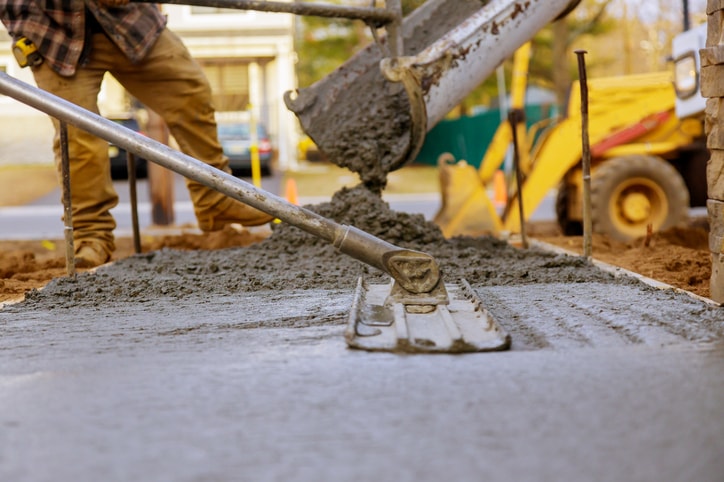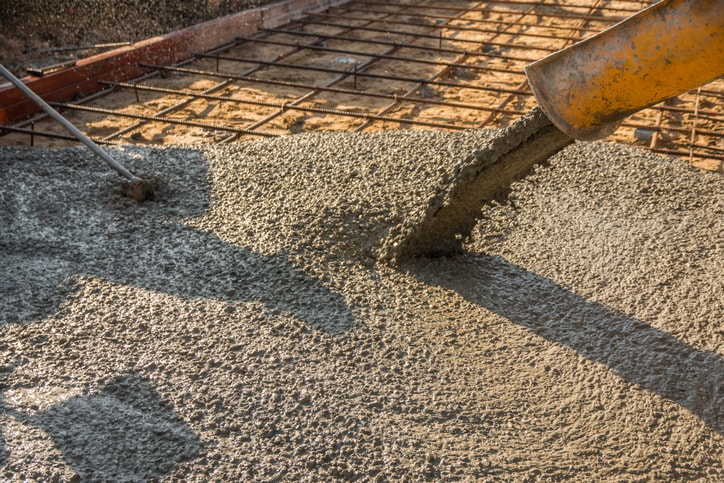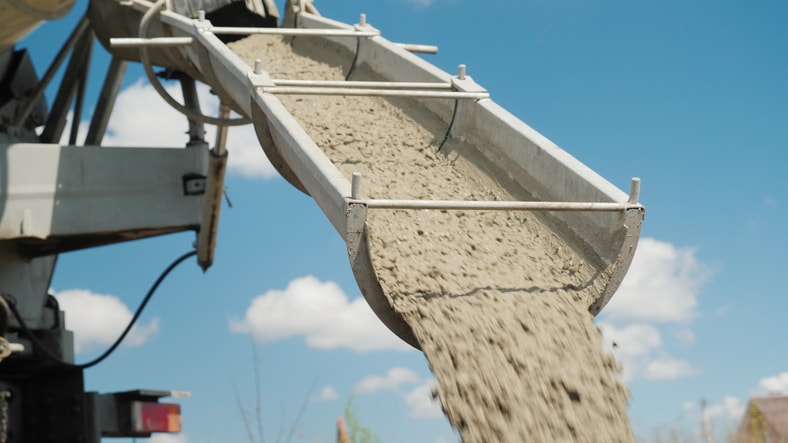
You likely interact with concrete every single day, and you don’t even think about it. When you go outside, you immediately interact with your driveway and your sidewalk. Concrete is also a big part of the house you live in, the roads you drive on, and the bridges you cross.
However, not all concrete is the same. That sidewalk in front of your house and the bridge you cross are made from two different types of concrete. As a matter of fact, concrete comes in many different forms. The one you’ll need for your home or business varies depending on the project — whether it’s for a backyard patio, a new driveway, or even public infrastructure.
Here are ten common types of concrete that you’ll encounter in everyday life.
1. Normal-Strength Concrete
Normal-strength concrete — also known as regular concrete — is the type you see most frequently in residential settings. The concrete mixes are generally in a ratio of 1:2:4. This means that it uses one part cement — usually Portland cement— two parts water, and four parts fine aggregates like sand or gravel.
The compressive strength you get from this type of concrete is generally suitable for small-scale construction projects that don’t need to withstand too much stress, such as sidewalks and patios.
Although normal-strength concrete isn’t the strongest, it might be perfect for your home. Having the highest strength can be overkill, especially when considering price, and this type of concrete is highly affordable.
2. Reinforced Concrete

If you ever watch a tutorial on how driveways are made, you may have noticed that construction workers will lay down the gravel base, and then they’ll set some rebar at a specific height. That rebar is what creates reinforced concrete.
This is another commonly used form of concrete that the construction industry will produce. We know that concrete is generally a strong material. But it’s also subject to cracking, especially on driveways where heavy vehicles are often parked. That’s why it needs to be reinforced with steel rods. The mixture of that and the concrete adds a lot of tensile strength to your concrete slab.
You’ll often see reinforced concrete in both residential and commercial buildings due to its ability to withstand various weather conditions.
3. Lightweight Concrete
Lightweight concrete, as the name suggests, is a less dense, often more pervious concrete than normal strength concrete. This makes it easier to work with and transport. It’s produced by using lightweight aggregates. So where normal concrete uses sand or gravel, lightweight concrete uses things like perlite or vermiculite. This reduces its own weight.
While it’s lighter than normal concrete, that doesn’t mean it’s less strong. It’s designed to withstand some of the same weights as normal strength concrete. Sometimes it can even be stronger.
Lightweight concrete is often used as building material in high-rise buildings. This makes sense when you think about it. Those buildings have to carry a lot of weight. So if you have lighter concrete, that makes the overall load smaller.
Not only that, it has low thermal conductivity, meaning it stays cool even when the sun is blaring down on it. This makes it good at protecting your building from any kind of heat damage. It also adds fire resistance to the overall structure.
A disadvantage to lightweight concrete is that it takes a while to dry. It’s very porous and usually has a lot of water content. It’s also harder to mix sometimes because the aggregates will sometimes separate from the rest of the cement.
4. Precast Concrete
Precast concrete is created by casting — or forming — concrete in a controlled environment, typically off-site, and then transporting it to the construction site. Once it’s there, all the construction workers have to do is put it together. They don’t have to worry so much about waiting for it to dry. That’s already been done.
Precast concrete blocks, panels, and slabs are frequently used for commercial buildings and infrastructure projects like parking lots, car parks, or even swimming pools.
5. Ready Mix Concrete

This type of concrete is most of the concrete you see. Ready mix concrete is made off-site and then transported to the construction site to be poured. When you spot those spinning concrete trucks, they’re transporting this type of concrete.
We can mix pretty much any kind of concrete whether it’s decorative, lightweight, or even high-density concrete.
The advantage to this is it creates less confusion at the site. Workers don’t have to stand around waiting for it to be mixed. It’s already done. They just have to prep the site, pour it, wait, and detail the concrete.
The main disadvantage to this type of concrete is that the place where it’s mixed has to be relatively close to the site. If it’s too far, the concrete mix won’t work. For this reason, it’s also not the best option for rapid-set concrete, which hardens quickly.
6. Decorative Concrete

Decorative concrete is what you want when looks matter. Regular, whitish-colored sidewalks and driveways are functional, but they aren’t always pretty.
This type of concrete is designed to be visually appealing while still maintaining the durability of traditional concrete.
At OKCrete, we install a lot of stamped concrete. We tend to pre-mix the concrete with the color of your choice. Then after it’s laid out, we go over it with stamps, which add texture. That texture can mimic the appearance of stone, brick or even wood. This is a more cost-effective option to get the look you want than laying individual pavers.
7. Glass Concrete
Glass concrete is another type of decorative concrete that’s gaining popularity. It incorporates recycled glass into the concrete mix. This serves three purposes:
- Strengthens the material.
- Creates a beautiful aesthetic.
- Gives you a green solution. The glass it uses is recycled. If you don’t use it for this, it would probably end up in a landfill.
Glass concrete is often used in decorative concrete applications, such as countertops, walkways, or even stamped concrete for patios and pool decks. The aesthetic appeal of glass concrete makes it stand out in residential and commercial projects alike.
8. High-Strength Concrete
High-strength concrete is used in demanding construction projects requiring a lot of durability and resistance. It achieves this by modifying the mix proportions of cement, water, and aggregates. Usually, you can use a lower ratio of water to cement or you can add more cement to the mixture.
Sometimes, we may also use a different type of cement altogether than what we’d use for regular concrete. For example a Portland type I cement might be best for normal strength concrete, but type III might be better for high-strength.
High-strength concrete is perfect for areas subject to heavy loads or harsh weather conditions, such as airport runways or large industrial floors. It’s a good option for areas that need to stand the test of time and resist freeze-thaw cycles.
9. Prestressed Concrete

Prestressed concrete is commonly used in large construction projects like bridges and high-rise buildings. In this type, internal stresses are introduced into the concrete mix before it’s even placed, which counteracts any potential tensile forces that could weaken it over time.
The way this is done is similar to how reinforced concrete is created. It just requires a few more steps. It starts out by putting the rods into some kind of frame with the ends of them sticking out. You add stress to the rods by pulling on them. While you’re doing this, you pour the concrete within the frame. Part of the rod is now inside the concrete while part of it is outside. You can either cut the rods after taking the frame off or keep them on depending on what you want to do.
This type of concrete is ideal for projects that require long spans without support beams, such as floors, roof slabs, and bridges.
10. Asphalt Concrete
Asphalt concrete is what you usually see on roadways. Most people either call it asphalt or blacktop. This type of concrete is made to withstand rough weather conditions and the stress that heavy vehicles are constantly putting on it.
How OKCrete Can Help
At OKCrete, we pride ourselves on offering a full range of concrete services, from residential to large-scale industrial projects. Whether you need a simple driveway or your looking for decorative concrete to beautify your outdoor space, we have the experience and skilled labor to get the job done right.
OKCrete’s team can help you choose the right concrete type for your needs. We’ve been serving the great people of Oklahoma City and Tulsa for over ten years. We’re confident that we can provide you with the best possible service.
Click here to request a quote today! We don’t offer every type of concrete that’s listed in this article. But if you want something we cannot provide, we’ll be happy to point you in the right direction.
